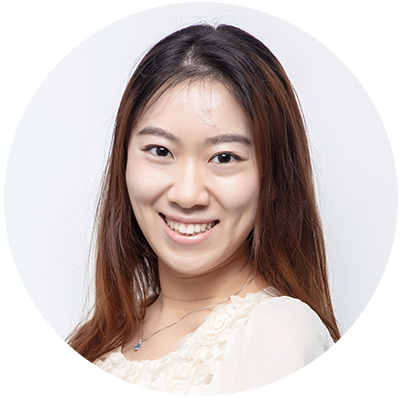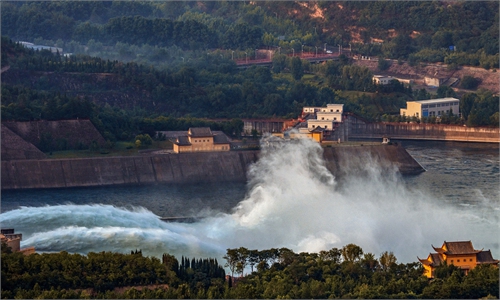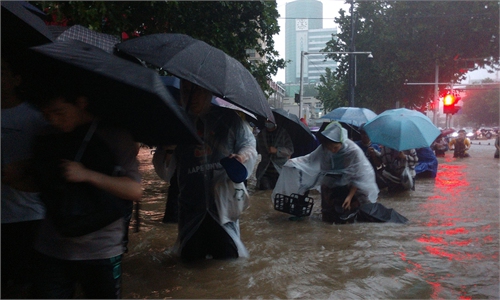Update: Record floods kill 33 in Henan, with 8 missing, as nationwide support pours in
Xi urges all-out rescue efforts, stresses people's safety, property first

Residents wade through a flooded street in Zhengzhou, capital city of Central China's Henan Province on Tuesday. Photo: Li Hao/GT
Death toll caused by the unprecedented heavy rainfall in Central China's Henan Province has climbed to 33, with eight still missing, local emergency management bureau said on Thursday.
A total of 376,000 people have been safely transferred and 256,000 relocated. The affected area of crops is 215,000 hectares, causing a direct economic loss of about 1.22 billion yuan.
The rain stopped temporarily during the day in the hardest-hit capital city, Zhengzhou, allowing the provincial capital to breathe, deal with the aftermath before it faces more rain in the evening.
The downpour that could overwhelm almost any city's drainage system prompted support from all over the country, as well as the central government's swift response. Yet it also raises questions for government of all levels over their response to emergencies and ability to properly deal with disasters.
When Global Times reporters arrived on Wednesday, paralyzed Zhengzhou East Railway Station, which sees more than 600 trains a day, was flooded. Many stranded passengers were sent to safe places in the city and the station was distributing food and water to those still stranded.
Cars piled on roads, some low places were still inundated, and most businesses along the streets remained closed. A few pedestrians carefully walked on the wet, muddy streets.
Sludge on most of Zhengzhou has been cleared out, standing water on girder bridges also cleaned out, as the Global Times reporters arrived.
Yet electricity was still a luxury for some parts of the city as of Wednesday afternoon, when the provincial government held a press briefing to update the situation, noting emergent repairs for power lines were ongoing. A total of 468 out of 602 power lines haven't been restored as of Wednesday night.
A downtown campus of the First Affiliated Hospital of Zhengzhou University was still out of power except for its ICU department. Some 600 critically ill patients were transferred to other hospitals as floodwaters, which devoured the first floor on Tuesday evening, had receded.
At least 25 people have died in Henan, with a subway inundated in Zhengzhou alone claiming 12 lives on Tuesday night. Gongyi county in Zhengzhou, 80 kilometers west of the downtown, reported at least four deaths after torrential rains caused a landslide, collapsing buildings and roads.

Henan, stand strong! No matter how severe the floods are, we are right behind you.
Nationwide support
The heavy rainfall, heaviest since the city kept records 60 years ago has been met by netizens praying on social media for the safety of Henan people, soldiers mobilizing for the rescue, and companies donating money and necessary materials.
Chinese President Xi Jinping on Wednesday demanded that authorities at all levels give top priority to ensuring people's safety and property, and carefully and strictly implement the flood prevention and disaster relief measures.
He ordered authorities at all levels to promptly organize flood prevention and disaster relief forces, properly accommodate those affected, strictly prevent secondary disasters, and minimize casualties and property losses.
The People's Liberation Army and the People's Armed Police Force must actively assist local authorities in emergency rescue and relief work, said Xi.
The PLA Central Theater Command had sent more than 5,100 soldiers, armed police and militia for emergency response to Henan for rescue operations.
Two-hundred PLA Rocket Force soldiers, carrying tools and kayaks, were also dispatched on Wednesday to rescue people trapped in many parts of Henan.
The Ministry of Finance has distributed 100 million yuan ($15.45 million) to support local flood control and relief efforts and restore the water conservancy facilities for agriculture. Henan is one of China's major crop production regions and contributed 10 percent of the country's total harvests.
Rescue teams from seven provinces have rushed to Central China to help transfer the trapped and tackle the secondary disaster risks of overflowing and landslides, before another round of heavy rainfall is expected from Wednesday night to Thursday.
Hotels in Zhengzhou lowered their prices for residents stranded, and convenience stores offered food and water to people in need. A cinema in Zhengzhou made headlines after it offered shelter for thousands of stranded people during the rainy night. The owner later told media that "I just did what I should do. Seeing helplessness in those people's eyes, their shivering bodies, I decided this was what I should do."
Many companies have donated, and some helped the transport and distribution of necessities.
A survivor of the Zhengzhou subway floods on Tuesday shared online her experiences after being rescued. Passengers tried their best to take care of the elderly and the pregnant, and encouraged each other until rescuers arrived.

Infographic: Wu Tiantong/GT
Rethink
Rain in Zhengzhou peaked between 4 pm and 5 pm on Tuesday at 201.9 millimeters in an hour, which is a third of the city's average annual precipitation. The rainfall on Tuesday was 552 millimeters, which was close to four times in Cologne, Germany between July 14-15, causing devastation that the "German language doesn't have words" to describe, as German Chancellor Angela Merkel put it.
Zhang Mingying, a weather expert from the Beijing Meteorological Bureau, told the Global Times on Wednesday that the massive rainfall in Zhengzhou has overwhelmed the capability of its drainage infrastructure and inundation was "unavoidable."
Urban designs are based on a certain standard of a city's flood control needs, which cannot withstand this kind of downpour, Zhang said.
Even the famous drainage system of Tokyo cannot handle the downpour in Zhengzhou. Tokyo can drain 200 cubic meters of rainwater per second, and it would take the system 2,000 hours to drain the 1.5 billion cubic meters of rainwater in Zhengzhou.
But some lessons can be learned to minimize casualties and losses.
The heaviest downpour in Zhengzhou arrived between 5-6 pm Tuesday, while the order to suspend operations of all subways was made at 6:10 pm. The subway station where the train was stuck was a tunnel lower.
After the deadly subway inundation, the Ministry of Transport urged on Wednesday all transportation organs in the country to check potential hazards of urban trail transit systems and stressed that those that cannot guarantee safe operation must be suspended.
Emergency response plans should be improved and stations in lower places must conduct frequent checks on its flood control facilities.
It is unrealistic to eradicate inundation after such a downpour, as the costs would be immense, said experts, noting that yet it is important to enhance a city's drainage to buy time to save lives and respond to emergencies, observers said, noting each city and village should have the capability to properly deal with disasters, including accurate command and public cooperation.
Wang Hongwei, a professor at the Renmin University of China's School of Public Administration and Policy, told the Global Times that while the city had seen continuous rain for days and issued red alerts, the messages were not fully delivered to city residents who went to work, school and daily activities.
Many residents reached by the Global Times said that though the downpour intensified on Tuesday, they did not expect rain of such scale the afternoon. "I chose to stay at my office overnight, which turned out to be a wise decision. But the government should have advised people to work from home before that, just like what Beijing did two weeks ago," said 26-year-old Zhang Yue.
Typhoon "In-fa" was cited for the downpour, exerting "remote control" over Henan as water vapor was pushed from the sea to Henan following the path of the typhoon, as well as air currents.
When the airflow hits the mountains in Henan, it converged and shot upwards, causing rain to be concentrated in this region.
Abnormal atmospheric circulation caused extreme weather like rain in Europe and the record heat wave in North America, climate expert Ren Guoyu told the Global Times. Yet, he dismissed the connection between heavy rain in Zhengzhou and global climate change, contributing yet to the abnormal planetary scale atmospheric circulation.
Experts also noted climate change means more vapor in the air, which may drive up the frequency of extreme rains, and less humid inland cities may see more downpours in the future.





